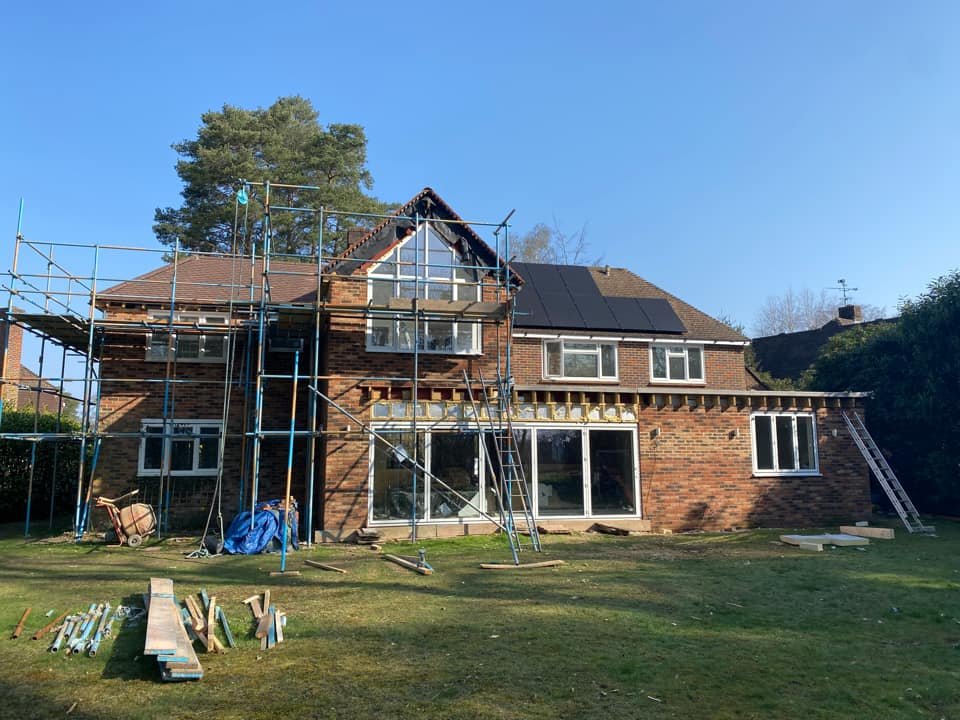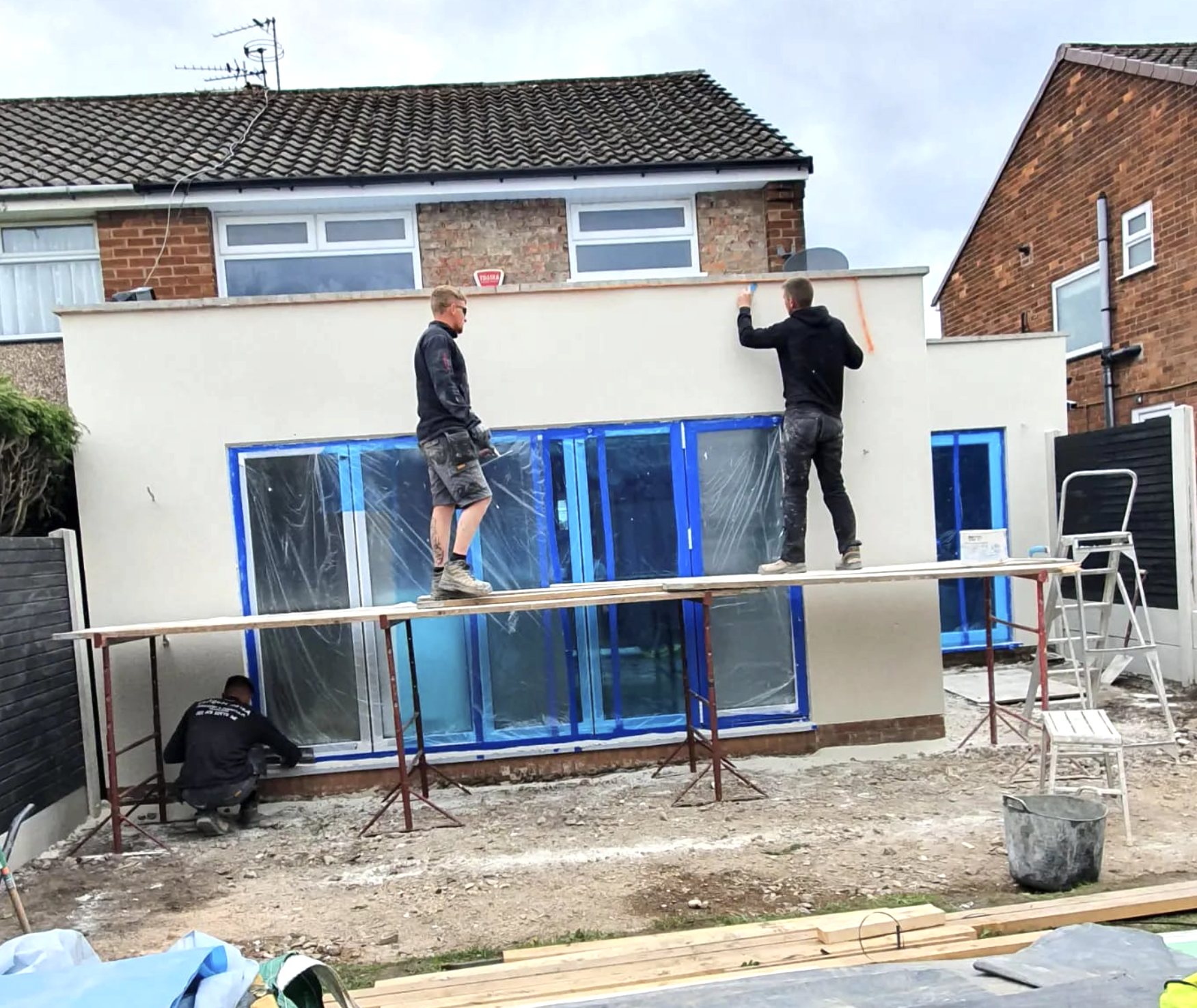Brick or Render: The Pros and Cons to Consider
Choosing the right finish for your building or extension project can be tough! But fear not, as we dive into the great debate between brick or render.
Which will reign supreme? We'll weigh up the pros and cons of each so you can make the best decision for your project.
First up, what is external render? Why go for it?
Our student ana’s fresh & smoothly rendered extension – beautiful!
No doubt you’ll have seen it on loads of properties you’ve viewed (because you’ll have been eyeing up whether it’s cracked!)
External render is like the face mask of building exteriors – a protective coating that keeps everything looking fresh and fabulous. Let’s just say it can correct a multitude of bad blockwork sins!
It's typically white, but can come in other colours and it’s completely re-paintable, so you can tie it in with your windows and doors scheme.
It's a popular choice for builders because it's easy and fast to apply, and won't break the bank. But just like a bad skincare routine, there are downsides to consider. Render can crack and show defects over time, and it might not be approved in certain areas where historical aesthetics are a concern. So, while it may not be a flawless solution, render can definitely give your building the makeover it needs.
Will it give you an edge in the Brick vs Render debate?! Let’s take a closer look…
Pros of Using External Render
Render is a fantastic choice for many building projects and is popular among builders in the UK. There are many pros for using render on your project, including:
Good value - it is likely one of the cheapest systems to use for the outside of your building project, particularly when combined with block-work.
Easy and quick to apply - Render is very simple and fast to apply, making it another reason it is popular with builders.
Most builders are happy to use it - particularly given the ability to reduce the time wet trades are active on your building site.
Cons of Using External Render
Render may be the belle of the ball for budget-conscious builders, but it's not all sunshine and rainbows.
Appearance - while the use of render can look great when used correctly, it is often considered unattractive compared to other materials.
Not always planning permission friendly - by extension, the material can be controversial in some areas, particularly conservation areas or on historical or listed sites.
Cracking and defects over time - given renders application as a single element, it has been known to suffer from cracking - much like internal plaster - where a building will move.
Maintenance - Given that render is typically white, it can require maintenance e.g. cleaning and resealing.
What about Brick? Is it worth it?
Bricks are the OG of building materials, having been around since, well, forever. They've held up countless walls and stood the test of time in the UK's architectural history.
Nowadays, when we think of bricks, we picture those uniform-sized stacks in stretcher or flemish bond, which are as common as a cup of tea in Britain.
…and just like a good cuppa, the classic yellow stock and bold red bricks are still a top choice for builders today.
Pros of Using Brick on a Building Project
As with render, brickwork provides a number of advantages that lend themselves to its popularity. Some of the pros you can expect with brickwork include:
Soundproofing capabilities – that could rival even your neighbour’s karaoke night
Timelessness - you can be assured that brick is definitely not just a passing fad
Very durable - Brickwork is very strong at not only staying in place but retaining its aesthetic quality over time
Low Maintenance - As with many of the historical brickwork seen around the UK, well-built brick walls may require some repointing, but largely are maintenance-free.
Lots of aesthetic options - While brick and its application are simple, the patterning, finishing, mortar and bricks available will give you plenty of choice and unique finishes for any project.
Planning friendly - Brick, on the whole, is typically a planning permission friendly material and is normally the recommended material when dealing with any sensitive projects in conservation areas and historical sites.
Cons of Using Brick
Just like any building material, brickwork also has its own set of cons that are worth considering before making a decision. Here are some of the potential drawbacks of using bricks:
Costs - it’ll set you back a fair chunk more than render will
Longer to construct - brickwork will typically take longer to erect, this typically has the added problem of a wet trade spending more time on the site, which can be messier for any builder or contractor.
Must be done correctly - it is important to ensure the bricklayer is conducting the work to a high standard in order to gain on the benefits of brickwork.
Matching bricks is difficult - Matching new bricks with existing bricks almost never works.
Pick the Correct Material for Your Project
While brick or render both have pros and cons, the key question should be which one is the best finish for your particular project. Always be sure to consider, plan and visualise the finishes you are looking to use and then try to pick the best finish for you.
Need help to prevent renovation mistakes?
We’ve produced a free 3 day email series to help new renovators feel clued up and confident before they begin their building work.
Learn:
How to cut costs and prevent your budgets spiralling
How to find trustworthy contractors who’ll deliver on time
What order to do work in (to prevent costly rework!)




